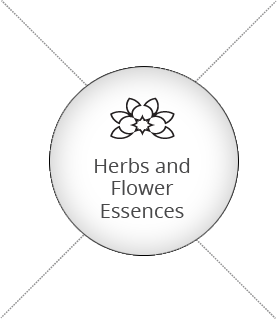Herbs and Flower Essences
Plants are most likely the first medicines humans used and use in healing. Even after the advent and advancement in modern pharmaceuticals, herbal medicines continue to be used frequently in the treatment of various ailments. References to their use are recorded in numerous textbooks, including ancient texts.
Modern research has confirmed the use of many herbs, including: cinnamon, for blood sugar regulation; turmeric, for inflammation; lemon balm, for agitation and nerves; cranberry, for bladder infections; black cohosh and chaste tree berry, for menopausal symptoms; ashwagandha, ginseng, and rhodiola, for energy problems; marihuana, for pain, seizures and inflammation; valerian, for anxiety and insomnia; and many others. Many herbal preparations have been researched and integrated into current medical practices, from the Chinese and Ayurvedic, Indian, tradition.
However, herbs can have toxic effects, sometimes acutely and at times from long-term use. Aristolochia (snakeroot) can cause kidney failure and cancer; Echinacea, Comfrey and Kava-kava can affect the liver, with potential failure; lobelia, used for asthma, can cause palpitations, low blood pressure, dizziness, tremor, and diarrhea; Scullcap, used for headaches, can affect liver function; yohimbine, used an sexual supplement, can affect blood pressure, cause heart arrythmias, cause respiratory depression and heart attacks; one needs to know how these substances work, their indications, contraindications and potential toxic effects before using to any significant extent.
Sometimes these compounds may be used with conventional medicines, but sometimes they may cause problems. For example, it is known for St. john’s Wort, used for depression and nerve injuries, can affect the function of hormones and creates sensitivity to the sun; quercetin, garlic, can thin the blood, so it may be contraindicated with Coumadin. There are similar herbs with challenging profiles.
Essential oils
These compounds are extracts that come from plants and barks; and, are not usually made from a whole plant. As extracts they tend to be very concentrated and are used dissolved in carrier oils, or vaporized in essential oil diffusers. There are many essentials that can be used therapeutically. Because of how strong they are they can often antidote homeopathic medicines; it is not recommended to used them close together.
Flower essences
There is usually very diluted essences of flowers, which are let stand in a carried liquid, usually alcohol, for long periods of time, to let the particulates of the plant infuse the solution. They are used mostly for emotional conditions.
The most common brand of flower essences used are called the “Bach Flower” preparations. Each flower or combination of essences has an indication, according to the teaching of Dr. Edward Bach, a British physician from the early 20th century. The most know compound is called “Rescue Remedy,” which is used for emotional upset. There are fine to be used together with homeopathic medicines.
Integrative Life Treatment Modalities

Medicine

Nutrition


Performance

Function
Coaching


Techniques

and Hypnosis

Natural
Remedies

Medicine

Flower
Essences











